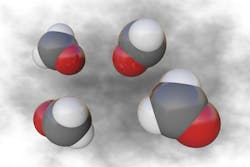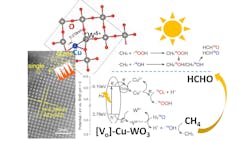A novel catalyst derived from tungsten trioxide has achieved near 100% conversion of methane to formaldehyde under 420-nm light irradiation and at room temperature.
Researchers from chemistry and chemical engineering departments at University College London, the University of Hong Kong and Tsinghua University, Beijing, China, collaborated to develop the material, which features a dual-active site comprising copper and tungsten atomic species that work in tandem to ensure an effective and selective conversion process.
Mechanistic analysis found that the tungsten trioxide substrate provides the visible-light responsive activity for methane conversion, while the atomically dispersed copper acts as an effective electron acceptor.
“Further research will be focused on improving the catalyst’s efficiency and selectivity,” said Zhengxiao Guo, professor of chemistry and mechanical engineering at the University of Hong Kong and corresponding author of a recent paper describing the work in Nature Communications. “Tasks include enriching the atomic active sites during catalyst synthesis and scale-up and to design innovative reactor systems, for example, to enhance solar/catalyst interactions and to achieve multi-pass reactions.”
Guo also notes that the dual-active site strategy developed here can be applied to other chemical reactions that involve multiple electrons to complete the process, such as water-splitting hydrogen generation and carbon-dioxide conversion into other chemicals.
“It extends the scope and flexibility for fine-tuning of the local microenvironment, so that reaction rate and pathways can be tailored to maximise productivity and improve selectivity,” he added. We are applying similar design strategies for other chemical reactions — with very promising discoveries in the pipeline.”
In terms of commercial potential, Guo says that one of the key challenges is to control the synthesis conditions and to tailor them for large reactors in scale-up reactions so that reproducibility is maintained for the catalyst performance. “Another challenge is to improve further the durability of such catalysts,” he said. “Both are also common issues with catalysts in general. We are working on ways of tackling those.”
The team is actively seeking industrial partnerships for continued development of the catalyst system and its practical applications. Guo says it is important to note that even the low concentrations of formaldehyde generated during the reaction can be applied in household, commercial and medical products. “Such low concentrations can be readily produced and applied on demand and on site, offering great flexibility for product design in the supply chain,” he concluded.
About the Author
Seán Ottewell
Editor-at-Large
Seán Crevan Ottewell is Chemical Processing's Editor-at-Large. Seán earned his bachelor's of science degree in biochemistry at the University of Warwick and his master's in radiation biochemistry at the University of London. He served as Science Officer with the UK Department of Environment’s Chernobyl Monitoring Unit’s Food Science Radiation Unit, London. His editorial background includes assistant editor, news editor and then editor of The Chemical Engineer, the Institution of Chemical Engineers’ twice monthly technical journal. Prior to joining Chemical Processing in 2012 he was editor of European Chemical Engineer, European Process Engineer, International Power Engineer, and European Laboratory Scientist, with Setform Limited, London.
He is based in East Mayo, Republic of Ireland, where he and his wife Suzi (a maths, biology and chemistry teacher) host guests from all over the world at their holiday cottage in East Mayo.


